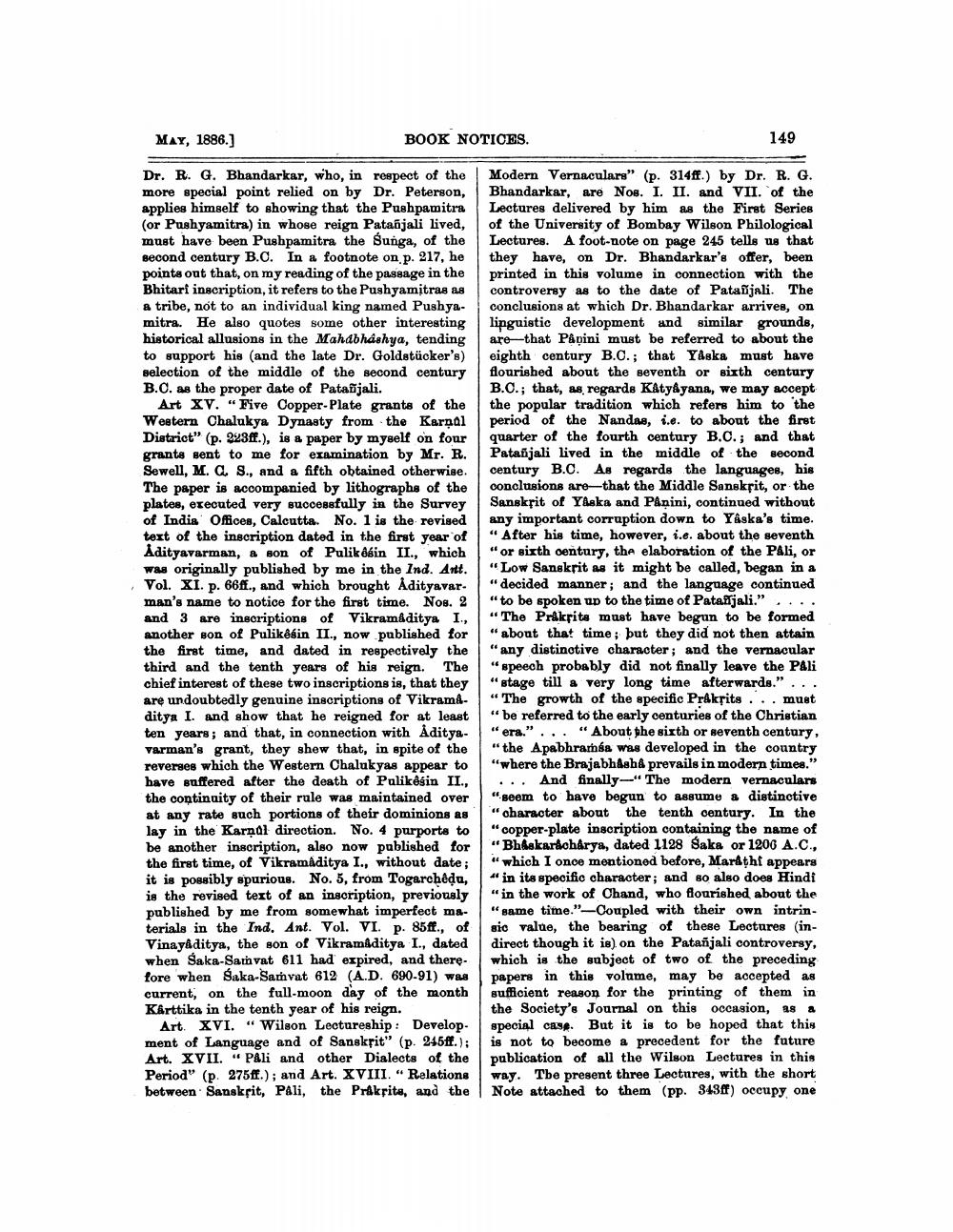________________
MAY, 1886.]
BOOK NOTICES.
149
Dr. R. G. Bhandarkar, who, in respect of the more special point relied on by Dr. Peterson, applies himself to showing that the Pushpamitra (or Pushyamitra) in whose reign Patañjali lived, must have been Pushpamitra the Sunga, of the second century B.C. In a footnote on p. 217, he points out that, on my reading of the passage in the Bhitari inscription, it refers to the Pushyamitras as a tribe, not to an individual king named Pushyamitra. He also quotes some other interesting historical allusions in the Mahabhashya, tending to support his and the late Dr. Goldstücker's) selection of the middle of the second century B.C. as the proper date of Patañjali.
Art xv. "Five Copper-Plate grants of the Western Chalukya Dynasty from the Karnal District" (p. 223ff.), is a paper by myself on four grants sent to me for examination by Mr. R. Sewell, M. a. s., and a fifth obtained otherwise. The paper is accompanied by lithographs of the plates, executed very successfully in the Survey of India Offices, Calcutta No. 1 is the revised text of the inscription dated in the first year of Adityavarman, a son of Pulik gáin II., which was originally published by me in the Ind. Ant. Vol. XI. p. 668., and which brought Adityavar. man's name to notice for the first time. Nos. 2 and 3 are inscriptions of Vikramaditya I., another son of Pulikesin II., now published for the first time, and dated in respectively the third and the tenth years of his reign. The chief interest of these two inscriptions is, that they are undoubtedly genuine inscriptions of Vikramaditya I. and show that he reigned for at least ten years; and that, in connection with Adityavarman's grant, they shew that, in spite of the reverses which the Western Chalukyas appear to have suffered after the death of Palikesin II., the continuity of their rule was maintained over at any rate such portions of their dominions as lay in the Karnal direction. No. 4 purports to be another inscription, also now published for the first time, of Vikramaditya I., without date; it is possibly spurious. No. 5, from Togarchéļu, is the revised text of an inscription, previously published by me from somewhat imperfect materials in the Ind. Ant. Vol. VI. p. 85ff., of Vinayaditya, the son of Vikramaditya I., dated when Saka-Samvat 611 had expired, and there. fore when Śaka-Samvat 612 (A.D. 690-91) was current, on the full-moon day of the month Karttika in the tenth year of his reign.
Art XVI.“ Wilson Lectureship: Develop. ment of Language and of Sanskrit" (p. 245ff.); Art. XVII.“ PAli and other Dialects of the Period" (p. 275ff.); and Art. XVIII. "Relations between Sanskrit, PAli, the Prakrits, and the
Modern Vernaculars" (p. 314ff.) by Dr. R. G. Bhandarkar, are Noe. I. II. and VII. of the Lectures delivered by him as the First Series of the University of Bombay Wilson Philological Lectures. A foot-note on page 245 tells us that they have, on Dr. Bhandarkar's offer, been printed in this volume in connection with the controversy as to the date of Patañjali. The conclusions at which Dr. Bhandarkar arrives, on lipguistic development and similar grounds, are that Påpini must be referred to about the eighth century B.C.; that Yåska must have flourished about the seventh or sixth century B.O.; that, as regarde Katyâyana, we may accept the popular tradition which refers him to the period of the Nandas, i.e. to about the first quarter of the fourth century B.O.; and that Patañjali lived in the middle of the second century B.C. As regards the languages, bis conclusions are—that the Middle Sanskrit, or the Sanskrit of Yaska and Panini, continued without any important corruption down to Yaska's time. " After his time, however, i.e. about the seventh "or sixth oentury, the elaboration of the PAli, or "Low Sanskrit as it might be called, began in a " decided manner; and the language continued "to be spoken up to the time of Patailjali." .... "The Prakrits must have begun to be formed "about that time, but they did not then attain "any distinctive character; and the vernacular “speech probably did not finally leave the PAli "stage till a very long time afterwards." ... "The growth of the specific Prakrits ... must "be referred to the early centuries of the Christian
"era." ... "About the sixth or seventh century, | the Apabhramba was developed in the country "where the Brajabhash& prevails in modern times."
... And finally-" The modern vernaculars "seem to have begun to assume a distinctive "character about the tenth century. In the "copper-plate inscription containing the name of "Bhaskaracharya, dated 1128 Saka or 1206 A.C., " which I once mentioned before, Marathf appears 4 in its specific character; and so also does Hindi "in the work of Chand, who flourished about the "same time."-Coupled with their own intrinsic value, the bearing of these Lectures (indirect though it is) on the Patañjali controversy, which is the subject of two of the preceding papers in this volume, may be accepted as sufficient reason for the printing of them in the Society's Journal on this occasion, as a special case. But it is to be hoped that this is not to become a precedent for the future publication of all the Wilson Lectures in this way. The present three Lectures, with the short Note attached to them (pp. 343ff) occupy one




